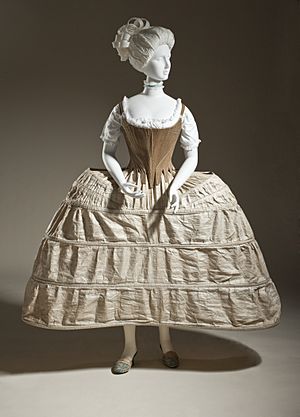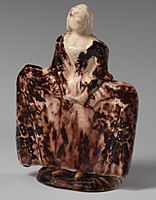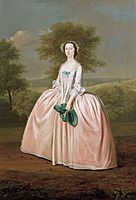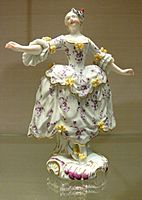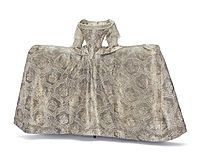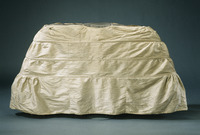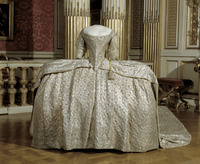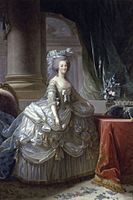Pannier (clothing) facts for kids
Panniers were special undergarments worn by women long ago. They were popular in the 17th and 18th centuries. Panniers made skirts look very wide on the sides. But they kept the front and back of the skirt quite flat. This wide, flat area was perfect for showing off fancy patterns and beautiful designs on dresses.
History of Panniers
The idea for panniers first came from Spain. They were seen in Spanish court dresses during the 17th century. You can spot them in old paintings by Velázquez.
This fashion then traveled to France. From France, it spread across the rest of Europe. This happened around 1718–1719. Some Spanish dresses were shown in Paris, which helped the trend grow. Some people also think panniers might have started in Germany or England. They were seen in England as early as 1710. They appeared in the French court near the end of King Louis XIV's rule.
The first panniers looked a bit like a crinoline from the 1800s. They were wide and rounded all the way around. But as they changed, panniers became different from earlier styles. For example, the farthingale from the late 1500s was wide in all directions. Panniers, however, were very wide only on the sides. They did not stick out much at the front or back. By the middle of the 1700s, the sides of the skirts became very sudden, not gently curved.
By the mid-18th century, a woman wearing panniers took up a lot of space. She could take up three times as much room as a man. At their largest, panniers could make a skirt several feet wide on each side! By the 1780s, panniers were mostly worn only for very fancy events. They were a part of special court fashion.
The word "pannier" comes from a French term. It means "wicker baskets" that are carried on the sides of a pack animal. Think of baskets hanging on a donkey!
Gallery
-
Marie Antoinette in a court dress of 1779 worn over extremely wide panniers.
See also
 In Spanish: Guardainfante para niños
In Spanish: Guardainfante para niños
- 1750–1795 in fashion
- Hoop skirt


